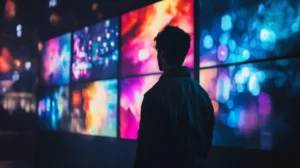
Home » CASE STUDIES & ARTICLES » LED Wall vs Multiple Display Screens: Which Is Better for Your Business?
LED Wall vs Multiple Display Screens: Which Is Better for Your Business?
Your customer walks into your retail space. Before they see your products, they notice your displays. The display technology you choose either amplifies your message or quietly undermines it.
LED video walls and multiple display screens look similar in photos, but perform like different animals in the real world. One punches through sunlight and creates seamless visuals. The other offers flexibility without the upfront cost.
The gap shows up in brightness, maintenance costs, and energy consumption. Most businesses learn these lessons after installation. This guide breaks down what separates LED walls from multiple displays so you can make the right call the first time.
Understanding LED Video Wall Technology
An LED wall consists of modular LED panels that snap together like building blocks without visible gaps. These panels use light-emitting diodes as individual pixels, with each LED acting as its own light source for exceptional image quality.
The lifespan ranges from 50,000 to 100,000 hours (over 11 years at 12 hours daily). LED video walls provide unmatched brightness and vibrant colours. Outdoor displays exceed 5,000 nits compared to around 500 nits for standard screens, remaining visible even in direct sunlight.
Excellent heat dissipation systems maintain performance during extended use. This makes LED displays ideal for storefronts, corporate offices, and outdoor advertising, where downtime costs money.
Multiple Display Screen Systems
Multiple display screens use individual LCD or LED monitors arranged together to form a larger viewing surface. Each screen operates independently, connected through video wall controllers that manage content distribution. These setups feature thin bezels, the frames around each screen, which remain visible and create a grid pattern across the display.
The configuration flexibility lets businesses adapt their video wall setup to available space. You can arrange screens in various patterns, expanding the installation as your needs grow without replacing existing hardware.
Pixel Pitch and Display Resolution
Pixel pitch refers to the distance between pixel centres, measured in millimetres. Think of it as how tightly packed the pixels are. This spacing impacts how sharp your display looks and how close people can stand before seeing individual dots.
A 1.2mm pixel pitch delivers clear visuals for viewers standing nearby. A 3mm pitch works better for audiences further away. Indoor LED displays typically use finer pixel pitches than outdoor installations because people view them from closer distances.
Quick rule: multiply the pixel pitch by 1 to calculate the minimum comfortable viewing distance in metres. A 2mm pitch needs viewers at least 2 metres away.
High Brightness Performance for Any Environment
Outdoor LED displays deliver brightness levels that multiple screens cannot match. The high brightness ensures visibility in direct sunlight, making LED walls the preferred choice for window displays, building facades, and outdoor events.
Multiple display screens typically offer brightness of 500-700 nits, sufficient for controlled indoor environments but inadequate for high-ambient-light conditions. The black mask between diodes on LED video walls absorbs ambient light, reducing glare while improving contrast.
Seamless Visuals vs. Visible Bezels
LED video walls create truly seamless displays where panels connect without gaps. Images flow continuously across the entire surface, providing an immersive visual experience. This seamless design proves particularly effective for large-format graphics, video content, and digital signage applications.
Multiple display screens always show bezels, even ultra-narrow options under 2mm. These visible seams interrupt visual continuity, though they matter less when displaying multiple content sources simultaneously. Software synchronises content across LED video wall panels for consistent performance.
Professional Installation and Hardware Maintenance
LED video wall installation requires professional expertise. Technicians align panels precisely and calibrate colour uniformity across the entire display. The modular design simplifies maintenance, allowing you to replace individual LED panels without dismantling the wall.
Multiple display screens offer a simpler initial setup with standard mounting hardware. Long-term maintenance presents challenges because screen failures require replacing entire units rather than swapping small modules.
Surprising Energy Savings and Efficiency
LED displays deliver bright visuals while consuming less power than expected. The surprising energy savings become significant in large installations running extended hours. Modern LED video walls use advanced power management that adjusts brightness based on ambient conditions.
Multiple display screens use LED backlighting too, but their individual power supplies and separate processors consume more electricity than unified LED wall systems. Lower power consumption combined with extended longevity reduces the total cost of ownership.
Digital Signage Applications Across Industries
Video walls serve retail, corporate, education, security, transportation, and hospitality sectors. Digital signage has become essential for businesses looking to enhance customer engagement and deliver dynamic content.
Retail environments benefit from:
- High-brightness LED displays that grab attention in store windows
- Creative LED displays for promotional campaigns
- Digital signage that drives customer engagement and increases dwell time
Corporate offices and control rooms rely on:
- LED video walls for effective communication during meetings
- Seamless displays for data visualisation and monitoring
- Interactive hardware options that enhance collaboration
Education and hospitality sectors use:
- Indoor LED displays for presentations and wayfinding
- Weather-resistant outdoor LED displays for campus signage
- Digital signage with remote content updates for timely messaging
Choosing the Right Display Technology for Your Business
Your decision depends on your environment, budget, content strategy, and visual quality requirements.
Choose an LED video wall when you need:
- Seamless, high-impact visuals without bezel interruption
- Outdoor LED displays or high-brightness indoor applications
- 24/7 operation with minimal maintenance
- Superior performance in challenging lighting conditions
- Creative LED displays with custom shapes and sizes
Choose multiple display screens when:
- Budget constraints limit initial investment
- Indoor environments with controlled lighting
- Flexibility to show multiple content sources
- Standard office or meeting room applications
Upgrade Your Business with DMX LED Wall Solutions
The right LED display technology creates experiences that connect your brand with customers.
At DMX, we specialise in video wall installations and digital signage for businesses. Our team delivers expertise in LED solution design, installation, and ongoing support. Enquire now to discuss your display needs and explore how we can enhance your space.

